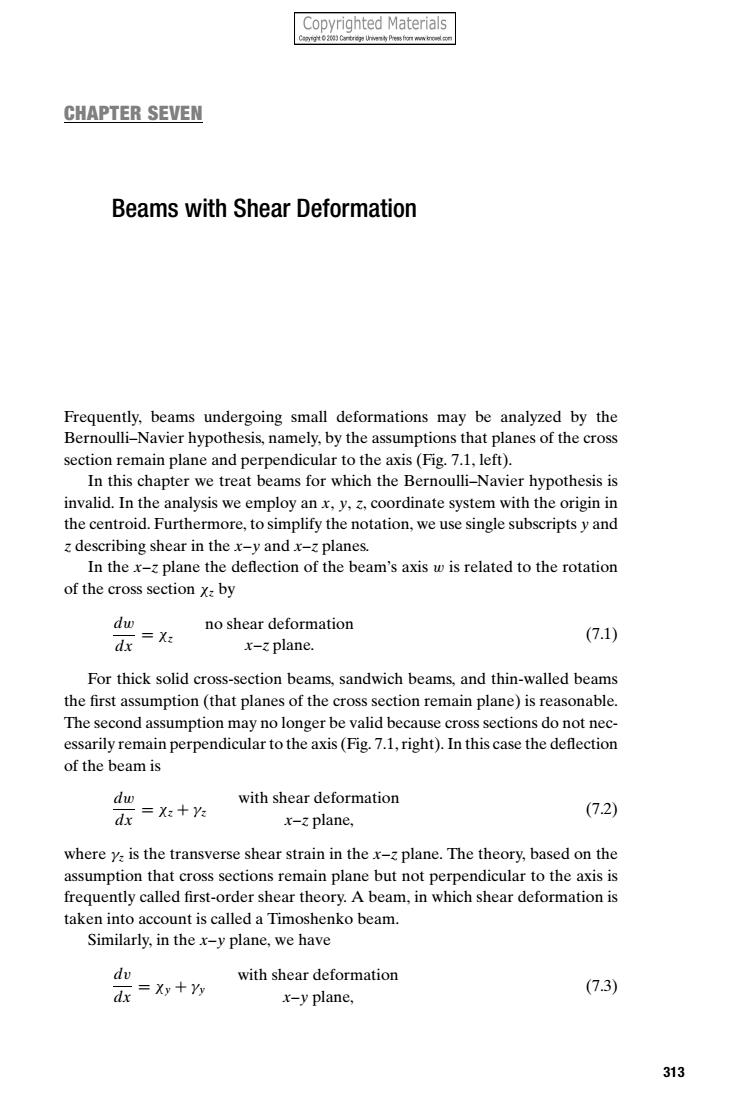正在加载图片...

Copyrighted Materials Cay2 Cr家yPress rt女gd CHAPTER SEVEN Beams with Shear Deformation Frequently,beams undergoing small deformations may be analyzed by the Bernoulli-Navier hypothesis,namely,by the assumptions that planes of the cross section remain plane and perpendicular to the axis(Fig.7.1,left). In this chapter we treat beams for which the Bernoulli-Navier hypothesis is invalid.In the analysis we employ an x,y,z,coordinate system with the origin in the centroid.Furthermore,to simplify the notation,we use single subscripts y and z describing shear in the x-y and x-z planes. In the x-z plane the deflection of the beam's axis w is related to the rotation of the cross section xa by dw no shear deformation dx =Xz (71) x-z plane. For thick solid cross-section beams,sandwich beams,and thin-walled beams the first assumption (that planes of the cross section remain plane)is reasonable. The second assumption may no longer be valid because cross sections do not nec- essarily remain perpendicular to the axis(Fig.7.1,right).In this case the deflection of the beam is dw with shear deformation dx =X:十y (7.2) x-z plane, where ya is the transverse shear strain in the x-z plane.The theory,based on the assumption that cross sections remain plane but not perpendicular to the axis is frequently called first-order shear theory.A beam,in which shear deformation is taken into account is called a Timoshenko beam. Similarly,in the x-y plane,we have dv with shear deformation dx =Xy+Yy (7.3) x-y plane, 313CHAPTER SEVEN Beams with Shear Deformation Frequently, beams undergoing small deformations may be analyzed by the Bernoulli–Navier hypothesis, namely, by the assumptions that planes of the cross section remain plane and perpendicular to the axis (Fig. 7.1, left). In this chapter we treat beams for which the Bernoulli–Navier hypothesis is invalid. In the analysis we employ an x, y, z, coordinate system with the origin in the centroid. Furthermore, to simplify the notation, we use single subscripts y and z describing shear in the x–y and x–z planes. In the x–z plane the deflection of the beam’s axis w is related to the rotation of the cross section χz by dw dx = χz no shear deformation x–z plane. (7.1) For thick solid cross-section beams, sandwich beams, and thin-walled beams the first assumption (that planes of the cross section remain plane) is reasonable. The second assumption may no longer be valid because cross sections do not necessarily remain perpendicular to the axis (Fig. 7.1, right). In this case the deflection of the beam is dw dx = χz + γz with shear deformation x–z plane, (7.2) where γz is the transverse shear strain in the x–z plane. The theory, based on the assumption that cross sections remain plane but not perpendicular to the axis is frequently called first-order shear theory. A beam, in which shear deformation is taken into account is called a Timoshenko beam. Similarly, in the x–y plane, we have dv dx = χy + γy with shear deformation x–y plane, (7.3) 313